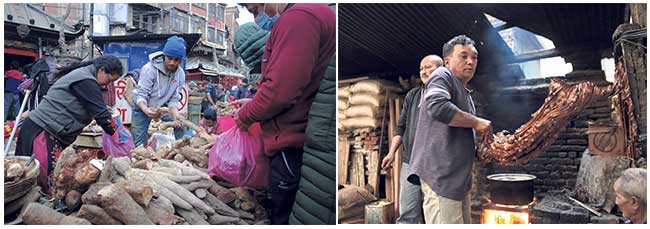KATHMANDU, Jan 15: On the first day of the Nepali month of Magh, people across the country celebrate Maghe Sankranti with special zeal and fervor. Nepali Hindus take a bath on the banks of various rivers to mark the day and pray to the sun with the belief to be relieved of their past sins. People also take part in different fairs that are held for the occasion.
Astrologically, it is the day when the Sun moves from the zodiac sign Sagittarius to Capricorn. It is observed as the end of winter season and start of longer days. After this day, it is said that any sacred ritual or auspicious events can be held. The day is regarded as a major harvest festival in the tarai region. On this day, the Tharu community observes Maghi, as the start of their new year. In Newar community, the day is observed as Ghya Chaaku Sanhu, where they put oil on their heads from the hands of their elders and eat pieces of molasses, ghee and fish.
Maghe Sankranti festival being celebrated today

Maghe Sankranti comes along with a wide variety of sweet foods including ghyu (ghee), chaaku (molasses), gund (jaggery), til ko laddu (a sweet dish made of sesame seeds) and bhuja ko laddu (a sweet dish made of rice puffs) among others. These item are also mixed together to give a new and combined flavor at each taste. Some also eat different sweets made with the combination of sugar, gund, and chaaku mixed with black and white sesame seeds that help keep one's body temperature in check and fight the cold weather.
During this time, one can observe huge markets around the city selling Maghe Sankranti-special foods and an especially busy market can be seen at Ason Chowk, where traders from various parts of the city come for an extra income. The horde of people at Ason Bazar can get quite overwhelming as Maghe Sankranti nears. Since food materials are high in demand, shopkeepers and vendors shift their usual business to selling food items of Maghe Sankranti. 57-year-old, Sil Ratna Tuladhar, who is a local of Ason, has been running a clothing shop here for the past 20 years. He, however, has been expanding his business for the past two decades by selling sweets during Maghe Sankranti. “I have been ordering the products from a wholesale shop at Ason. Knowing that a huge crowd of customers arrive here to buy necessary items for the festival, most of us extend our services as per the customers’ need and demand,” said Tuladhar.
Since consuming the above mentioned sweet items is the culture and it contributes to the trade market every year, the prices of those items are quite affordable for every Nepali. A medium packet of til ko laddu is being sold for Rs 60 and 200 gm of ghee for Rs 150. Since chaaku can be stored for a longer period of time, the demand has been higher compared to other items. As much as 500 gm of chaaku is being sold for Rs 80 while a packet of pustakari for Rs 90. “I have been selling these items for the past four years and every year the number of people visiting Ason especially for Maghe Sankranti is increasing. Since Tokha is famous for ghyu and chaaku, most of the products that I sell come from there,” said Bhaktapur resident and a street vendor, Anisha Maharjan. “Among all the items, til ko laddu has been selling like hot cakes,” she added.
Yams and sweet potatoes are also consumed on the day. 43-year-old Renu Tamang has been selling a wide variety of yams including tarul (yam), ban tarul (wild yam) and mude tarul along with sweet potatoes. “These foods are high in demand as they are a part of our culture, are organic and have medicinal values,” said Tamang who has been selling them for the past 25 years. She added that the prices are quite reasonable ranging from Rs 50 to Rs 400, depending upon the demand. Pattaley, a type of yam, is brought from Dhading and sold for Rs 180/kg, while yam comes from Sarlahi and is sold for Rs 80/kg. Similarly, panglange and mude tarul is brought from Palpa and sold for Rs 100/kg, while hattipaile comes from Butwal and is sold for 140/kg. Likewise, sweet potato comes from Jhapa and is sold for Rs 80/kg, and yam from Chitwan is sold for Rs 70/kg. The rarest of all is ban tarul, which is procured from the jungles and is priced higher than the rest. It is sold for Rs 400/kg.
Likewise, sweet potato comes from Jhapa and is sold for Rs 80/kg, and yam from Chitwan is sold for Rs 70/kg. The rarest of all is ban tarul, which is procured from the jungles and is priced higher than the rest. It is sold for Rs 400/kg.
“Tarul and sweet potatoes are widely popular in Kathmandu, but we have customers coming in from many places to buy food items of all types. Because of the expanded market, the sales have been comparatively decreasing now,” added Tamang.


































